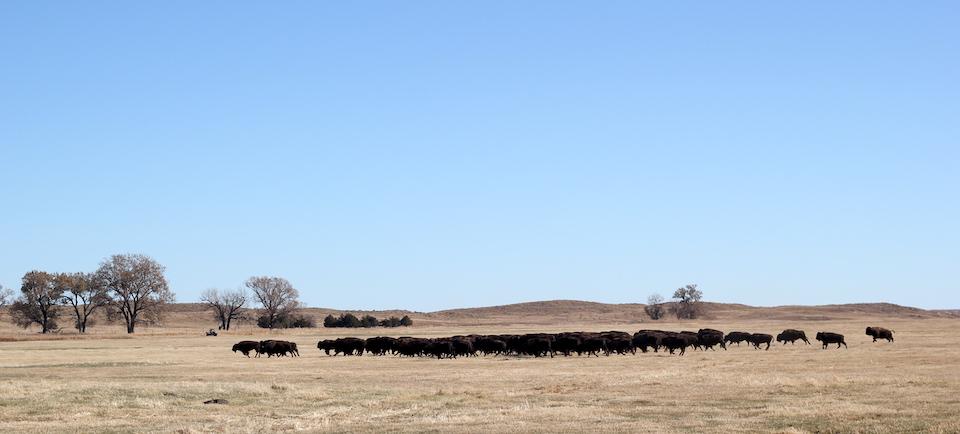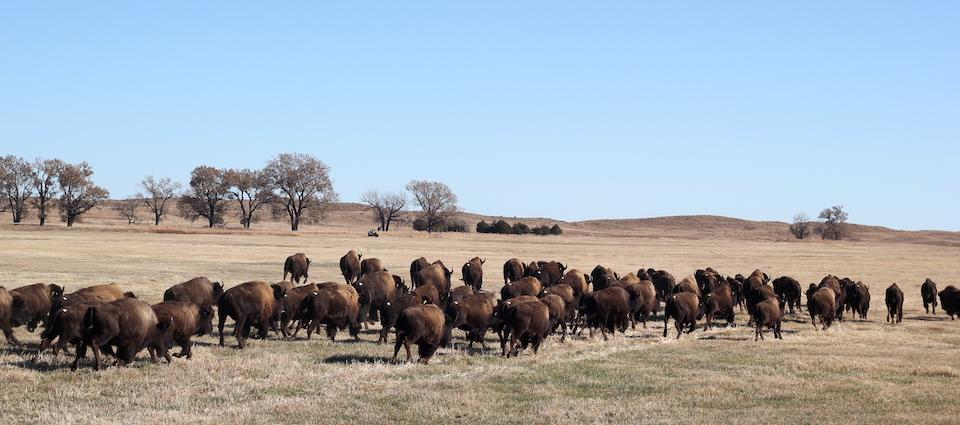
100 bison from Theodore Roosevelt and Badlands national parks have been transferred to the Rosebud Sioux nation/NPS
Prospects for prairie grasslands, Lakota culture, and reservation economics and health have been boosted with the arrival of 100 bison from Badlands and Theodore Roosevelt national parks at the Wolakota Buffalo Range on the Rosebud Sioux Indian Reservation.
The bison marked the first of an estimated 1,500 that the tribe hopes to manage on 28,000 acres of South Dakota grasslands that once were grazed by livestock.
“The sacred relationship between Native nation communities and the buffalo is part of a shared story of strength, resilience and economic revitalization,” Wizipan Little Elk, CEO or REDCO, the Rosebud Economic Development Company, said Friday when the transfer occurred. “The arrival of the buffalo marks a new beginning for the Sicangu Oyate, where cultural, ecological and economic priorities are equally celebrated and supported and are of great benefit to our community.”
It was back in May when Interior Secretary David Bernhardt announced a decade-long initiative to support efforts to better understand genetic pools held within the Interior Department's roughly 11,000 bison and to bolster conservation and ecological efforts with states and tribes.

The bison were released Friday on the Wolakota Buffalo Range/NPS
At the time, the secretary said bison from the Rocky Mountain Arsenal National Wildlife Refuge in Colorado would be transferred to Theodore Roosevelt National Park in North Dakota, and another transfer would send bison from Interior's herds to the Rosebud Sioux Reservation in South Dakota.
Those events happened this past week, with the wildlife refuge last Tuesday sending six yearling cow bison to Theodore Roosevelt, where they will be studied to see how translocated animals integrate into established herds, and on Friday when the 100 park bison arrived at the Wolakota Buffalo Range.
“We are part of the DOI effort to conserve wild, healthy herds of bison which requires our best scientific work within DOI, and diverse partnerships of public agencies, private partners, and native nations," said Margaret Everson, the National Park Service's acting director. "DOI’s partnership in today’s establishment of the Wolakota Buffalo Range represents real progress in that direction. This herd will also support economic development, job creation, education and food sovereignty for the Rosebud Sioux Nation.”
The lead partners for the Wolakota Buffalo Range event are the Rosebud Economic Development Corporation, which is the economic arm of the Rosebud Sioux Tribe, and the World Wildlife Fund. There are five supporting DOI bureaus: Bureau of Indian Affairs, Bureau of Land Management, U.S. Fish and Wildlife Service, the National Park Service and the U.S Geological Survey.
Other actions are planned under the Bison Conservation Initiative, which dates to October 2008 when then-Interior Secretary Dirk Kempthorne launched the program.
It's been estimated that when Columbus reached the new world in 1492 that there were as many as 60 million bison in North America, roaming from Canada to Mexico and as far east as Virginia. But they were almost driven to extinction in the later half of the 19th century by "buffalo hunters" who worked to feed railroad crews, provide hides to merchants, and for the military in its efforts to drive native cultures onto reservations by eliminating their "commissary," the bison that provided them with food, shelter, tools, and more.
By the turn of the 20th century there were thought to be only 400 or 500 bison left in the United States. The majority of those were in private hands, such as with ranchers Charles Goodnight and Charles "Buffalo" Jones. No more than two dozen bison were thought to remain in the wild, and they were deep within the interior of Yellowstone National Park.
The Department of Interior’s Bison Working Group, made up of scientists and managers from the five supporting DOI agencies that work on landscape-level collaborative conservation and restoration issues, will be working with a range of partners for additional bison transfers as well as continued bison health and genetic studies, and ecological and cultural restoration projects.



Comments
It does my heart good to see that the terrible wrong that was committed in the 19th century is being properly addressed. We can only hope that the damaged done to the Indigenous people and their culture can be mitigated. The return of the Bison is a big step in that direction.
I'm happy to see some of our original bison returned to our lands
As the "white people" had demolished from our lands our food our shelter.
I am proud of my heritage even though my grangrandfather had been shamed and sent back to reservation every time he had left.